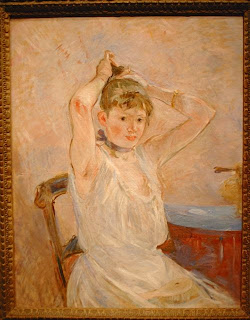Saturday, September 14, 2013
Early Modernism at the Modern
This is not a very good show. Surprising as one would think the roots of Modernism would be seen here. The Modern Museum of Art comes from Europe and the American rivulets have been largely passed over.
Much better examples are in Kansas City and St Louis and other Museums across the country. I suppose NY museums were cool to the work and it was easier to give locally, I'm not sure.
One thing is that the future of American art was not so much influenced by these works. The Modern Museum's work is so lack luster it seems to keep this idea in check.
I have had the opposite idea coming across the US visiting Museums I see really great examples everywhere.
Some can be seen here.
The lineage in American art of these earlier modern artists do have some history but it is not told here at the Modern.
Stuart Davis has had a larger influence but they have nothing of his late work up.
Hartley which this is a great example has not been influential, as figuration which he has influenced has not been a large part of Modernism. O'Keeffe's influence seems mainly to lesser art.
Dove is a favorite of a lot of abstract painters.
I personally think these artists are a place to go back and look around.
They still had an idea of nature which is good in relation to our new idea of the Earth.
Hopper is very illustrative and why alot of this art and period is seen in a dim light, though there are tropes in his work about nature and alienation of the Modern which can be useful. Birchfield though can be underrated. He is a surprise.
 |
| Hopper |
 |
| Dove |
 |
| O'Keeffe |
 |
| Stuart Davis |
 |
| Edwin Dickinsen |
 |
| Hartley |
 |
| Sheeler |
Monday, September 2, 2013
Homer at the Clark
I was set to thinking of Melville as I passed Greylock Mountain on the way up to Williamstown.
"swells heaving up like immense subsiding, waves far and wide around it."
Here are some of the classic ocean paintings to go along with that.
It is interesting to see how great the paint is bravura quality I guess coming from Manet and that tradition.
"Look at Nature, work independently, and solve your own problems." Very Yankee, of the time! But it makes sense to wonder what he meant by it.
Bernard Berensen says something about Piero that his figures stand 'silent like the everlasting rocks.'
I read that in Italy seeing the Peiro della Francesca's in 1972 and have always remembered it.
So seeing the Piero downstairs and then these connected it all. The way I love Art History to line up.
A detail of above.
Clark Art Institute
I felt a lot of associations between paintings today. The Piero starts it all out with it's classical reality from the Greek.
I've always loved this head to foot relation of Piero which makes a very solid reality which echoes through Art History and right here today in the Homers.
Homer has this classic solidity. Especially in some etchings which the Clark doesn't own.
That same solidity is in this Renoir and also in his Sculpture.
I wonder if the Homer's reality is coming through Goya. He takes the classic and relaxes it into the everyday, but the underpining is still there. This is a great little Goya.
Homer is also extending from Manet. There is a great Watteau here also which show the lineage of bravura paint, I usually associate with Hals, and Goya. Here Berthe Morrisot.
This Renoir also shows the classical outline and shape.
This is surprisingly a Singer Sargent, I see the Morisot portrait by Manet!
Sunday, September 1, 2013
Subscribe to:
Posts (Atom)










































